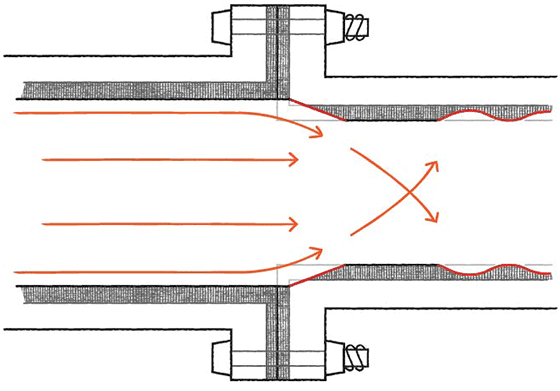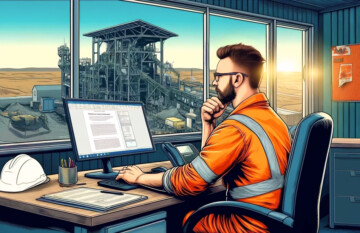If you’ve been putting bore matching in the too hard basket, it’s now time for a rethink. It might seem like extra work, but the long-term benefits will far outweigh the additional hours you commit to getting it right—so you can set and forget.
Bore matching involves matching the internal diameter (ID) of all the elements in your slurry piping system. This includes the pipework, hoses, valves, flow meters, and other instruments.
We’ve put together this guide that explains:
- Why it’s important to match the ID of your system
- Types of wear commonly caused by ID misalignment
- How to bore match your process plant or pipeline
Why it’s important to match the ID of your system
In our experience, there are three main causes of premature wear in slurry piping:
- Incorrect geometry (such as short radius bends)
- Poor piping selection
- Pipe ID misalignment
All of these wear types cause pipes to wear and leak before they should do. This causes more work and safety issues for your plant maintenance team who have to organise unplanned maintenance to repair the spools.

Leading edge wear was causing leaks and downtime in this plant
Once this wear cycle begins, it continues, to the point where the spool can completely fail if it’s not addressed. This is the dreaded ‘downtime’ situation where you have to scramble to come up with a solution.
Types of wear commonly caused by ID misalignment
Leading edge wear
ID misalignment causes two types of wear: Leading edge wear and turbulent wear.
Leading edge wear happens when slurry is flowing from a larger ID pipe to a smaller ID pipe. This is the most obvious form of wear and is noticeable when the pipe is replaced or rotated. Wear is accelerated on the flange faces and the liner.

Fig. 1: Leading edge wear
Fig. 1 shows severe localised wear on a pipe end (smaller ID spool), wearing through the wear liner on the flange face and internal (on ends). Once this wears down to the steel, the spool won’t last long. The direct impact on the smaller spool leading edge causes accelerated wear at this point. And it causes turbulence in the remainder of pipe due to the uneven flow of slurry.
Turbulent wear
When slurry moves through a smaller ID pipe into a larger ID pipe, it creates turbulence and back eddies. You’ll often see this type of wear further downstream where the piping changes to a larger ID (Fig. 2).

Fig. 2: Turbulent wear
Matching the ID of the pipework eliminates this type of wear. Some industries mitigate turbulent wear by rotating pipework. For example, when processing plants experience significant sliding wear abrasion, maintenance teams will rotate pipes twice (two 90° turns) to increase the life of the pipework. But even with this type of predictive maintenance, the pipes will have to be replaced due to the ID misalignment.

An example of turbulent wear in rubber-lined pipe
How to bore match your process plant
Decided you need to bore match your system? Great idea! Here’s the best way:
1. Work out what ID you want to target
Whether it’s for hydraulic efficiency, or if you have a particular element in your slurry piping system where the bore can’t be changed, think about the diameters that are already fixed. This might be a valve or flow meter that isn’t economical or practical to change. You then match the ID of all the other piping to this component.
2. Consider your lined piping options
Castable liners, such as high-performance polyurethane systems are a great option if you want to match your pipework’s ID. Castable liners allow you to vary your liner thickness to achieve a matched bore. So it’s worth checking with your piping manufacturer if they use these.

Abrasiguard polymer-lined pipe is an example of a castable liner
3. Think about castable liners for valves
This is often overlooked, but there are valve supplies who offer cast bore liners so you can vary the valve’s bore ID. Generally, a conventional valve ID is designed to match the ID of standard width unlined pipe. That’s obviously not ideal when using lined piping.
4. Talk to instrument suppliers about custom liners
With instruments like flow and density meters, ask them whether they can provide a custom liner that can achieve the ID you want. If they can’t, talk to an aftermarket supplier that can retrofit one.
5. Select a bore size for hydraulic efficiency
When you choose a bore size, think about the slurry’s parameters and the pumping energy required so you can maximise your hydraulic efficiency. This is particularly important in long distance pipelines.

Fig. 3: Bore matched piping
Bore match for a better quality system
Bore matching is the small detail that will enhance your plant’s productivity.
It might seem minor, but inconsistent internal diameters are one of the main types of wear in slurry piping. So, it’s worth taking the time to put systems in place to correct the IDs early.
In the long run, you’ll find that it saves you both operating and maintenance costs—so you’ll hit those production targets no problem.













